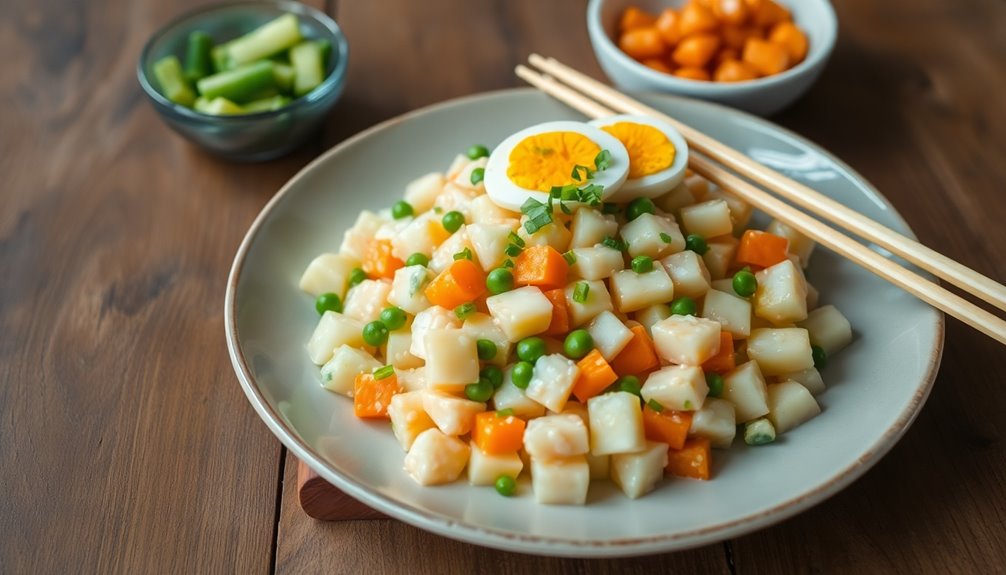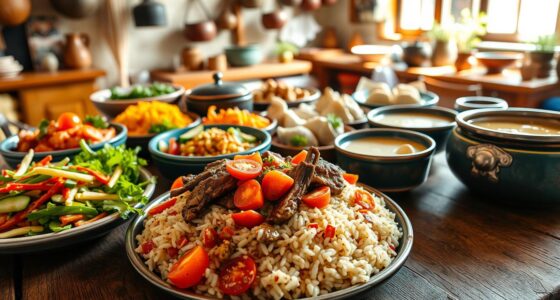Japanese potato salad, or Oriental Olivier, blends creamy russet potatoes with colorful veggies like carrots and cucumbers, all mixed with Kewpie mayonnaise for a unique flavor. Originating from the Meiji Era, it reflects Western culinary influences while becoming a beloved staple in Japanese cuisine. Enjoy this delightful dish at family gatherings or picnics, and don't be afraid to experiment with additional ingredients! There's so much more to discover about its cultural significance and preparation techniques.
History
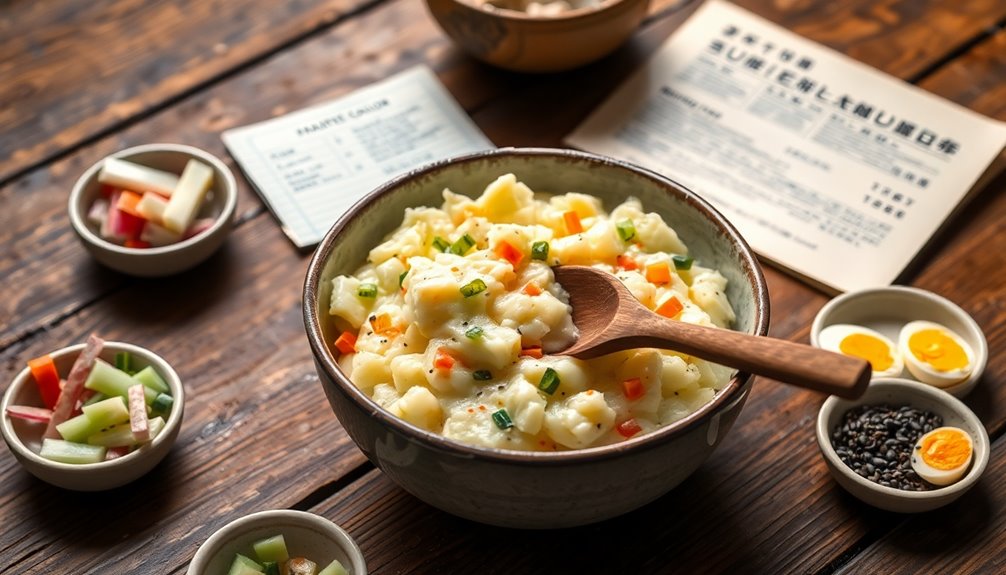
Japanese Potato Salad has a rich history that dates back over 120 years, originating during the Meiji Era when culinary exchanges between Japan and the West began to flourish.
Adapted from the Russian Olivier Salad, it reflects the influence of Western cuisine, particularly through the introduction of mayonnaise. Kewpie mayonnaise became a defining ingredient, setting it apart from traditional Western potato salads.
This popular dish in Japan showcases colorful ingredients like corn, carrots, and cucumbers, enhancing both visual appeal and flavor. Each family often adds its own touch, highlighting regional preferences and personal tastes.
This evolution of Japanese Potato Salad exemplifies the cultural exchanges that transformed a simple dish into a beloved staple at gatherings and celebrations across the nation. Furthermore, the use of mayonnaise in this dish parallels the historical context of butter's incorporation into various culinary traditions, showcasing how ingredients evolve with cultural influences.
Recipe

Japanese Potato Salad is a delightful dish that balances creaminess with a medley of colorful vegetables, making it a favorite side dish in many households. This salad, which has roots dating back to the Meiji Era, showcases a different approach to potato salad compared to Western versions, focusing on a smoother texture with just the right amount of chunkiness.
The combination of russet potatoes, vibrant veggies, and Kewpie mayonnaise creates a deliciously unique flavor profile that will leave your taste buds wanting more.
To prepare this dish, you'll start by boiling the russet potatoes until they're tender. While the potatoes cook, chop the vegetables like carrots and cucumbers and prepare the dressing with Kewpie mayonnaise, rice vinegar, salt, and black pepper. Once everything is ready, you'll mix the ingredients together to create a creamy and satisfying salad. It's perfect for family gatherings, picnics, or as a side to any meal.
Ingredients:
- 4 medium russet potatoes
- 1 medium carrot, diced
- 1 small cucumber, diced
- 1 cup corn (fresh or frozen)
- ½ cup Kewpie mayonnaise
- 1 tablespoon rice vinegar
- Salt, to taste
- Black pepper, to taste
- Optional: ½ cup diced ham or 2 boiled eggs, chopped
- Optional: 1 teaspoon HonDashi and 2 tablespoons sliced scallions (for Salaryman Potato Salad variation)
Cooking Instructions:
Begin by peeling and cutting the russet potatoes into quarters, then boil them in salted water until fork-tender, about 15-20 minutes.
Meanwhile, cook the diced carrots and corn in separate pots until tender, then drain and allow to cool. Once the potatoes are cooked, drain and let them cool slightly before mashing them in a large bowl, leaving some chunks for texture.
Add the cooled carrots, corn, cucumbers, Kewpie mayonnaise, rice vinegar, salt, and black pepper to the bowl. If using, add diced ham or boiled eggs at this stage. Mix everything until well combined, then refrigerate for at least 30 minutes to let the flavors meld.
Extra Tips:
For the best flavor and texture, make sure to use russet potatoes as they mash well and create a creamy consistency.
You can adjust the amount of Kewpie mayonnaise and rice vinegar based on your taste preferences; some may enjoy a creamier or tangier salad. Feel free to experiment with additional ingredients like avocado or different vegetables to suit your palate.
Remember to store leftovers in an airtight container in the refrigerator for up to 3–4 days or freeze for longer storage. Enjoy your Japanese Potato Salad as a versatile side dish that pairs wonderfully with many meals, and consider how diversification in your meal planning can enhance your diet and overall health!
Cooking Steps
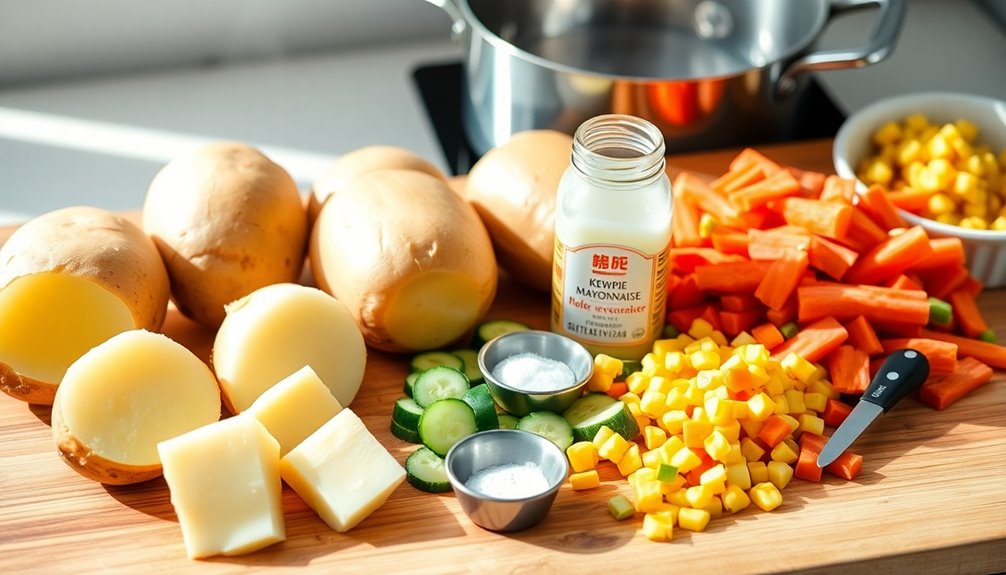
To get started on your Japanese potato salad, you'll want to boil your peeled and diced russet potatoes until they're tender.
Once they're ready, mash them gently with a fork, leaving some chunks for texture.
Then, mix in your diced vegetables and Kewpie mayo, seasoning with salt and pepper to taste. Additionally, you may want to consider diversifying investments in your meal preparation by incorporating a variety of ingredients for enhanced flavor and nutrition.
Step 1. Boil Potatoes Until Tender

Before you begin making your delicious potato salad, it's essential to boil the potatoes until they're tender.
Start by placing peeled and diced russet potatoes in a pot of cold, salted water to ensure even cooking. Bring the water to a boil, then let the potatoes cook for about 10 to 15 minutes, or until they're easily pierced with a fork.
Once tender, drain the potatoes and transfer them to a large bowl to cool, which prevents further cooking. Remember to season the cooking water with salt, as it enhances the flavor absorption.
For optimal texture in your salad, let the cooled potatoes sit before mashing them gently, leaving some chunky pieces for added substance. Incorporating natural elements into your cooking process can enhance the overall experience and flavor of your dish.
Enjoy!
Step 2. Mash Potatoes With a Fork
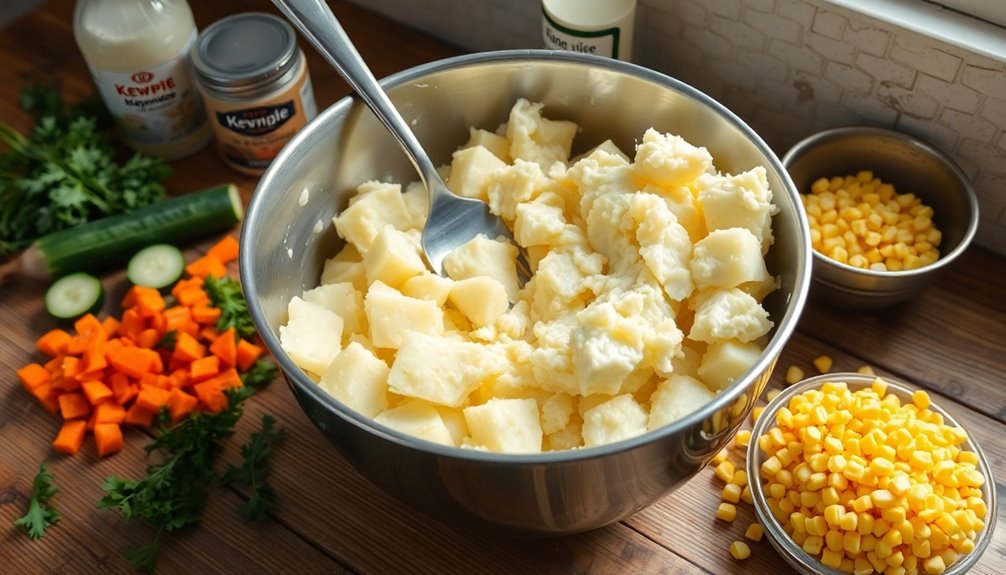
Start by transferring the cooled, drained potatoes into a large mixing bowl.
Using a fork, gently mash the potatoes, ensuring you leave some larger chunks for a better texture while achieving a creamy mix.
For the Japanese version, you can add finely chopped hard-boiled eggs at this stage.
Gradually incorporate Kewpie mayonnaise and a splash of rice vinegar to bring out the perfect balance of flavors.
As you mash, season to taste with salt and pepper, adjusting the consistency to your liking.
It's essential to mix well, so the flavors meld nicely. Incorporating a side of herbal tea can complement the meal and enhance digestion.
Step 3. Add Diced Vegetables
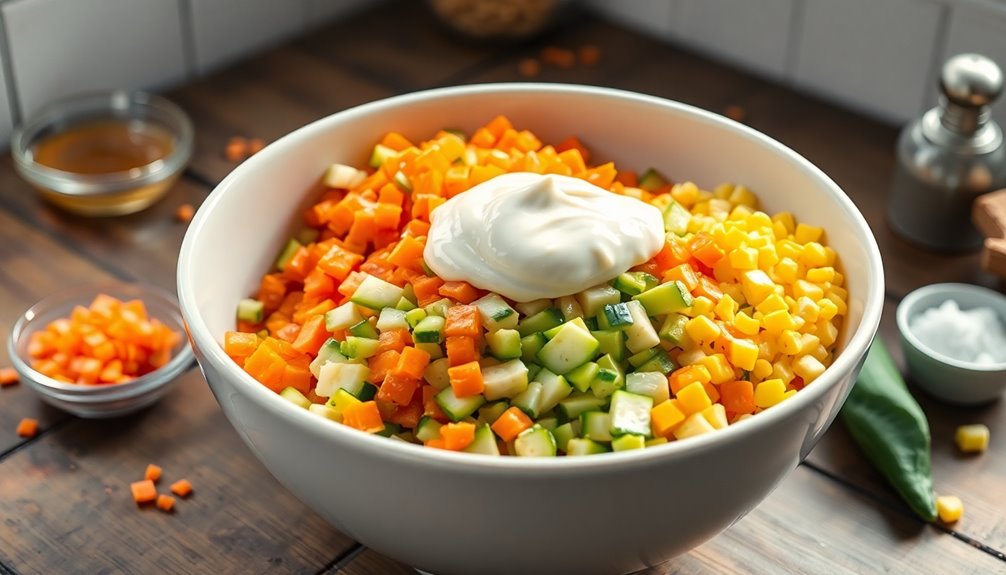
Adding diced vegetables brings vibrant flavor and texture to your Japanese potato salad.
Start by boiling diced carrots and potatoes in salted water until fork-tender—about 8-10 minutes for the carrots and 10-15 minutes for the potatoes. Once cooked, drain the vegetables and rinse them with cold water to halt the cooking process, preserving their color and texture.
For the cucumbers, slice them thinly and sprinkle with salt, letting them drain for about 10 minutes to remove excess moisture.
After the potatoes cool, gently mash them, leaving larger chunks for added texture. Finally, mix in the diced vegetables, including the cucumbers and carrots, which will enhance the salad's overall flavor before you add the mayonnaise. Additionally, consider incorporating freshly squeezed juices to complement the salad with a refreshing dressing.
Step 4. Mix in Kewpie Mayo

Gently fold Kewpie mayonnaise into the cooled mashed potatoes, ensuring it evenly coats the mixture. This key ingredient brings a rich, tangy flavor that truly enhances your Japanese potato salad.
As you mix in Kewpie mayo, add in the diced cucumbers, carrots, and corn, aiming for an even distribution without overmixing. Depending on your preference, use about ½ to 1 cup of Kewpie mayo to achieve the desired creaminess.
For an extra flavor boost, consider incorporating a splash of rice vinegar into the dressing. Once everything's well combined, refrigerate the salad for 30–60 minutes. This resting time allows the flavors to meld beautifully, making each bite of your Japanese potato salad even more delicious. Additionally, using natural remedies like Kewpie mayo can enhance your overall culinary experience.
Step 5. Season With Salt and Pepper
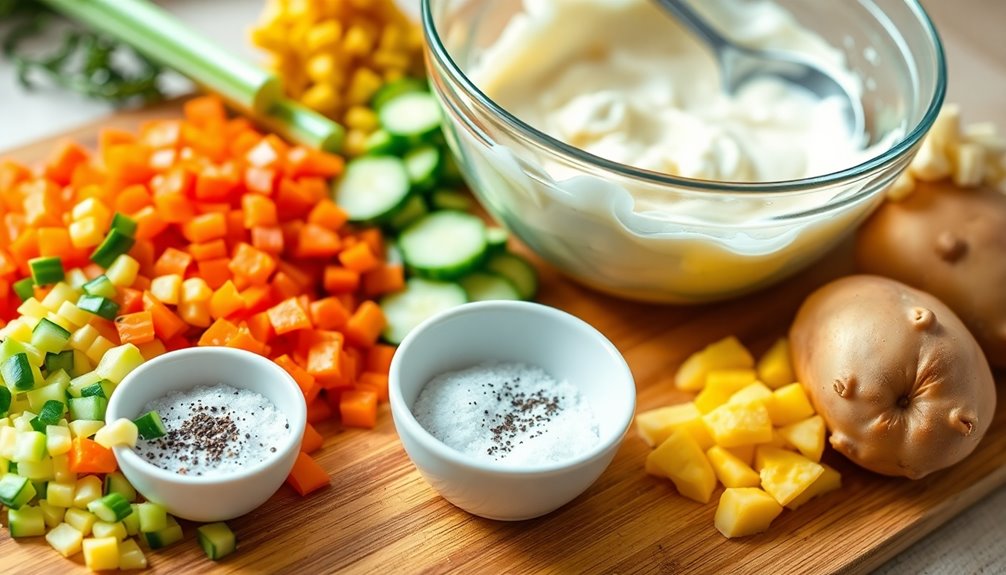
Once the Kewpie mayo and vegetables are mixed in, it's time to enhance the flavor of your Japanese potato salad.
Start by seasoning the cooking water with salt while boiling the potatoes; this helps them absorb flavor. After draining, let the potatoes cool slightly before mashing to keep some texture.
For the cucumbers, salt them and let them drain for about 10 minutes to reduce excess water, preventing a watery salad.
Next, season your potato salad with salt and pepper to taste, balancing the creamy mayo flavor.
For optimal taste, refrigerate the salad for at least 30–60 minutes before serving. This allows all the flavors to meld beautifully, resulting in a delicious dish. Additionally, serving the salad at the right temperature is crucial for enhancing its overall image quality, as it can affect how flavors are perceived.
Enjoy!
Final Thoughts
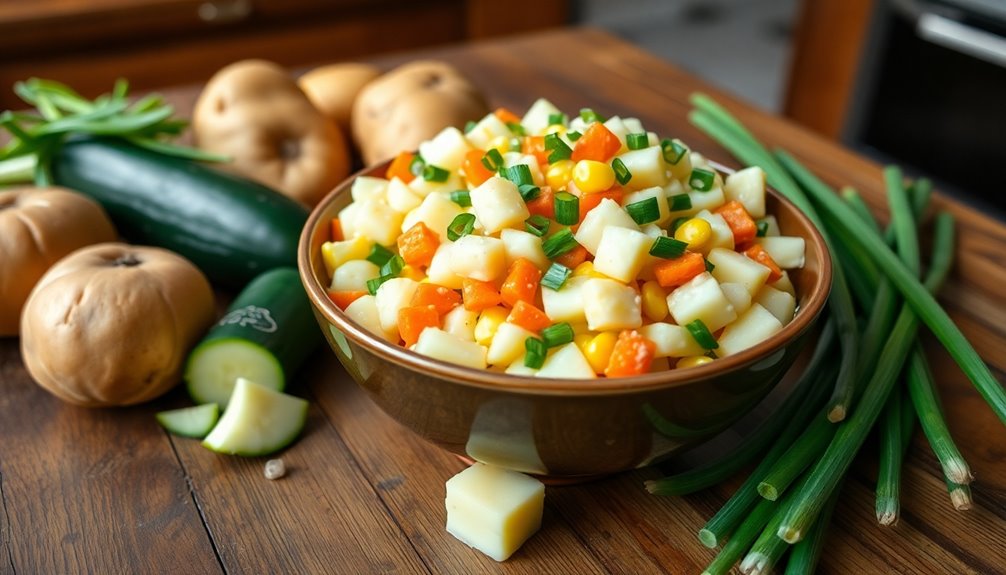
While you might think of potato salad as a simple side dish, Japanese Potato Salad elevates this classic with its creamy texture and vibrant flavors.
The use of Kewpie mayonnaise gives it a rich, tangy taste that perfectly complements the colorful vegetables like cucumbers, carrots, and corn. Unlike chunkier American versions, this salad features a mashed consistency, creating a delightful blend of flavors in every bite.
You'll love how refrigerating it for 30–60 minutes enhances the melding of tastes.
With origins linked to the Russian Olivier Salad, this dish has been a popular offering for over 120 years, making it a favorite at family meals and gatherings.
Originating from the Russian Olivier Salad, this beloved dish has been a staple at family gatherings for over 120 years.
Its unique flavor profile is further enhanced by fermented vegetable plates, which can provide a complementary taste experience when served alongside this salad.
Try it, and you'll see why it's so beloved!
Frequently Asked Questions
What Makes Japanese Potato Salad Different?
Japanese potato salad stands out for its creamy, smooth texture, primarily using mashed potatoes rather than chunks.
You'll notice colorful ingredients like corn, carrots, and cucumbers, adding both sweetness and crunch.
The use of Kewpie mayonnaise gives it a unique, rich flavor that's different from typical dressings.
Light seasoning with rice vinegar, salt, and black pepper balances the taste, creating a refreshing dish that highlights simple, fresh vegetables.
What Was the Original Olivier Salad?
The original Olivier Salad, created in the 1860s by chef Lucien Olivier, featured a luxurious mix of finely diced meats, vegetables, and a rich mayonnaise dressing.
You'd find boiled potatoes, carrots, pickles, peas, and bologna in this opulent dish, reflecting the tastes of Russian aristocracy.
Served at the renowned restaurant L'Hermitage, it became a signature dish, celebrated for its harmonious balance of creamy and crunchy textures, perfect for festive occasions.
What Is the Difference Between Sweet Potato and Oriental Sweet Potato?
Think of sweet potatoes and oriental sweet potatoes as two siblings in the vegetable family, each with their own unique charm.
Sweet potatoes are creamy and sweet, perfect for comforting dishes. In contrast, oriental sweet potatoes boast a drier, nuttier flavor, wrapped in purple skin.
They're starchier and denser, making them great for roasting or steaming.
Nutritionally, you'll find oriental sweet potatoes higher in fiber and lower on the glycemic index, offering a healthier option.
What Is the Difference Between Japanese and Korean Potato Salad?
When you compare Japanese and Korean potato salad, you'll notice some key differences.
Japanese potato salad usually features a creamy, mashed texture with simple seasonings like rice vinegar and black pepper, while Korean potato salad has a chunkier consistency with various vegetables and sweeter additions like apples.
The flavor profiles differ too, with Korean salad often incorporating mustard or sesame oil, making it richer in taste compared to the more subtle Japanese version.
Conclusion
In the end, making Japanese potato salad, or Oriental Olivier, is a delicious way to explore new flavors while keeping things simple. You'll find that this dish is not just a meal but a delightful blend of textures and tastes that can brighten up any gathering. So, roll up your sleeves, get creative in the kitchen, and enjoy the fruits of your labor. After all, it's the little things that make the biggest impact!
